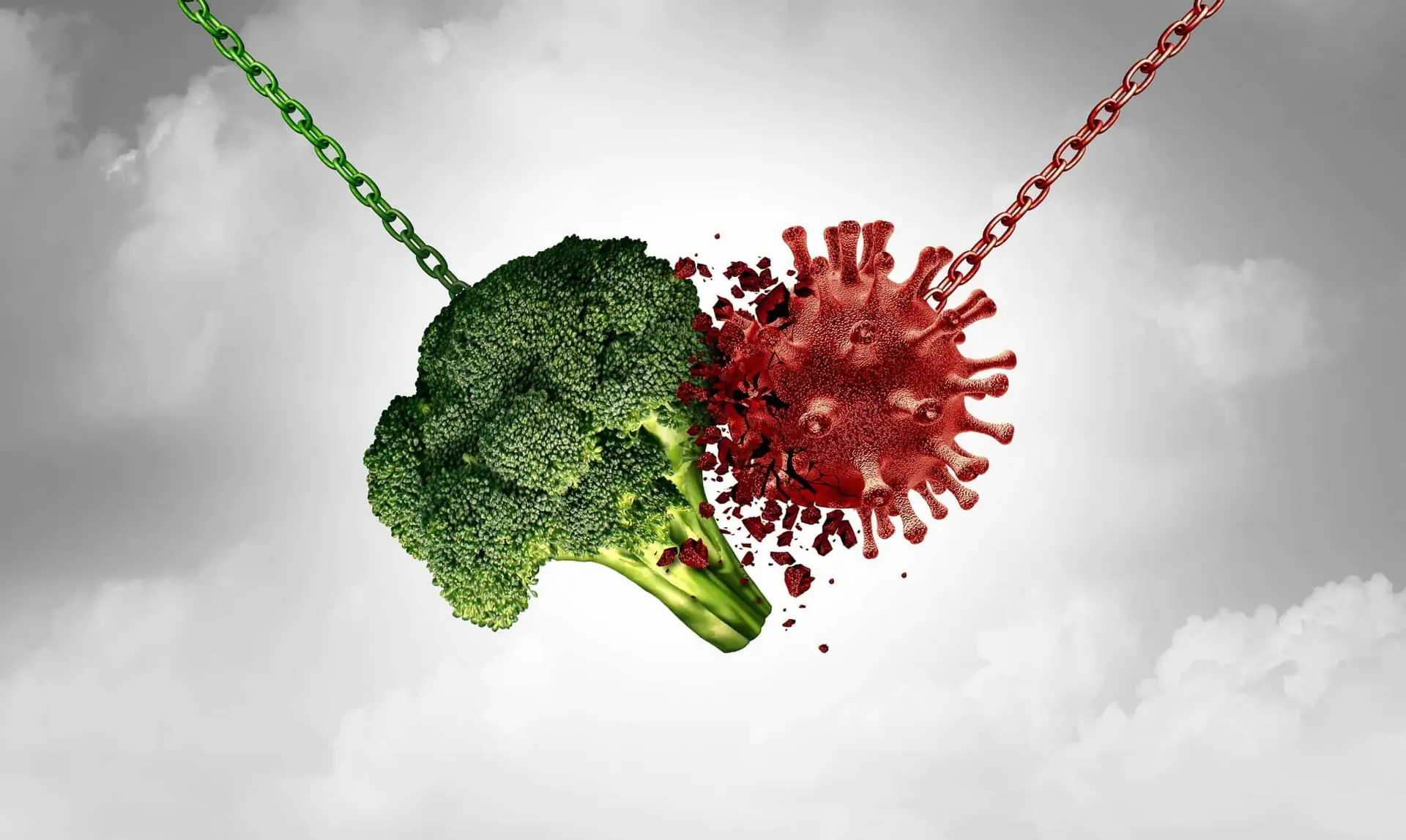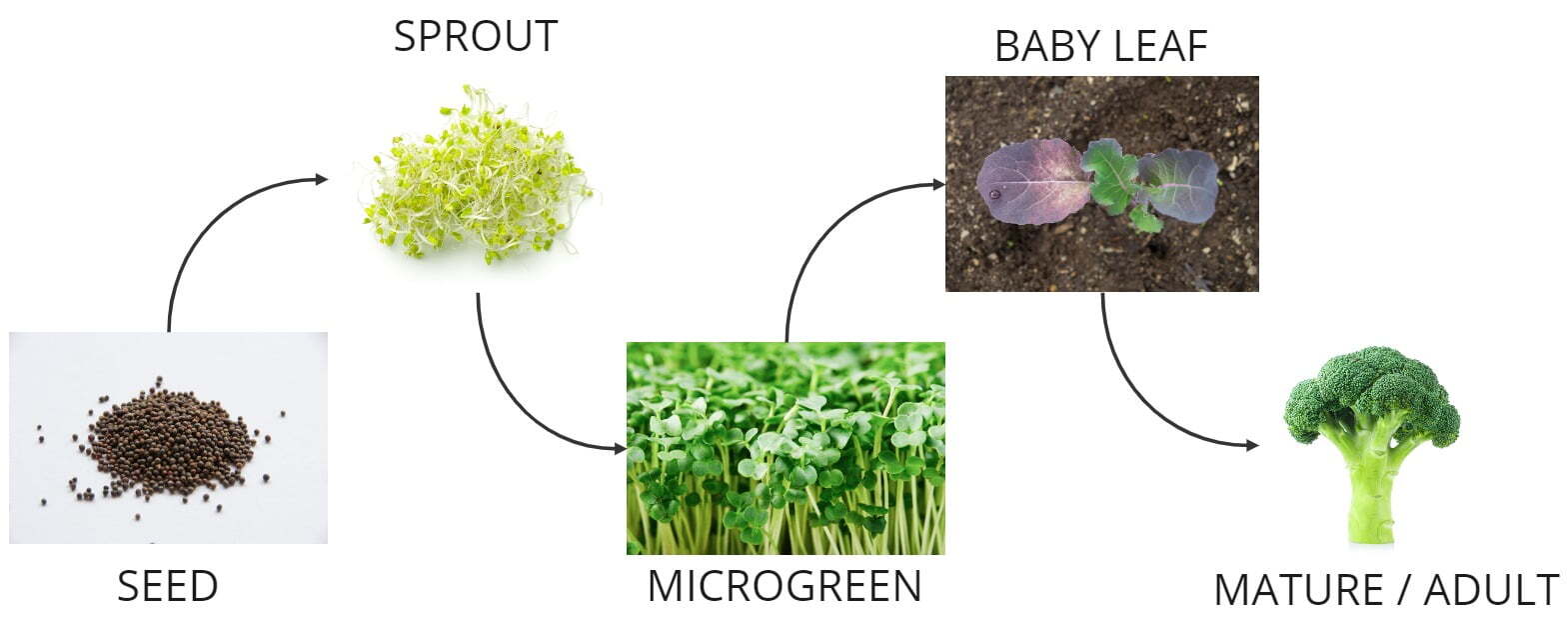Broccoli Anti-Cancer Benefits – Sulforaphane

Sulforaphane – Expressed through Microgreen Broccoli Powder
Broccoli in almost any form is fantastic, and raw broccoli is better for you than cooked broccoli. We often get asked about why the microgreen form of broccoli is better than other forms. Let’s look at the stages of broccoli growth so we are on the same page.
Plant Growth Stages
In my view “Better” is not the right way to think of it. Each form of broccoli has different nutrient characteristics, needs vary from person to person and we also need variety in our diet. In our family we regularly have the microgreen and mature broccoli and have also been testing Natural Yields’ new Microgreen Broccoli Powder.
At Natural Yield we focus on growing the microgreen broccoli for commercial use. We believe it provides the best health-value for money option for our nutrient conscious clients.
[side-note: Sprouts are normally grown to sprout stage through a contained, high moisture, high humidity environment (a jar). At Natural Yield, we have chosen not to offer sprouts due to increased health risks sprouts can present in commercial production, packaging and travel. We grow our microgreens through the sprouting stage in an inert coco coir media, in the dark, and with only minimal water.]
Broccoli microgreens have up to 40 times more of some nutrients than the same weight of mature broccoli. So, if you really want to amplify your uptake of some nutrients then microgreen broccoli could be a solution.
Dr. Eric Berg DC has a YouTube channel we subscribe to. Dr. Berg has done some great videos on the subject or broccoli – one of them is The Best Form of Broccoli Is..
Broccoli sprouts can generate ten times more sulforaphane and twice the amount of calcium than mature broccoli. In the video Dr. Berg also reveals that “the absorption rate from mature broccoli is only 19%, while the absorption rate from broccoli sprouts is 74%”. For people who have difficulty with absorption, or simply want to multiply the benefits this is great news!
In the video Dr. Berg explains that “Sulforaphane also has potent anti-cancer properties. It helps your body excrete carcinogens. So not only does sulforaphane help reduce your risk of cancer, but it also helps get rid of things that increase your risk of cancer. “
In 100g samples, broccoli sprouts contained 1153mg of sulforaphane, while broccoli contained 55-171mg. So, that means Broccoli sprouts can contain up to 20X more sulforaphane than adult broccoli.
At Natural Yield, we recently invested in freeze drying technology which means we are able to produce Broccoli Microgreen Powder. This product will be available in the Natural Yield Shop in the new year once we complete our quality assurance process.
You can only eat so much of anything! We personally know cancer fighters that are very focused on eating loads of microgreens, especially broccoli.
The problem can be that, for some people it can be difficult on the digestive system, especially for colon cancer This was very personally relatable to us as my own father, who was a cancer patient given 6 months to live (over a year ago), could not tolerate raw broccoli microgreen well. He has been doing fine with the microgreen broccoli powder however.
The microgreen broccoli powder, in weight terms, concentrates the raw product down to around 5% of the raw weight (as ~95% of the weight comes from water).
This means that 5 grams of powder is roughly equivalent to 100 grams of raw microgreen – that is essentially a 20x concentration of broccoli!
This provides a highly convenient option for getting goodness into you while still enjoying raw microgreens as usual.

Sulforaphane Expressed Through Broccoli Powder
Freeze Drying vs Dehydrating
Natural Yield invested in freeze drying instead of the much cheaper, less effective and more nutrient damaging dehydrating option. Preserving the integrity and nutritional value of the microgreen is of utmost importance, which is why we chose freeze drying over dehydrating. We are really focusing on being able to control the process end-to-end, from seed to harvest, milling, freeze-drying and packaging. This way we can have confidence in the product we sell.
Dr. Rhonda Patrick, another person we follow, provides a lot of deep insights into the science behind this subject. If you can keep up with her she definitely is worth it! This video was particularly interesting:Q&A with Dr. Jed Fahey on Sulforaphane, Moringa and Chemoprotection [An authoritative discussion!]
In this video, Dr. Jed Fahey estimates that 2 ounces (60 grams) “is a reasonable amount to put you in a zone where you are getting some protective effect.”
In conclusion, eat more broccoli in all its forms! Eat a wide variety of vegetables. Prevention is better than cure.
Sprouts vs Microgreens
We rely on the analysis of the organisations properly equipped and funded to do the research. The analysis is very expensive and requires specialised skills and equipment – especially if the analysis has to be performed for every species and for everything that could be tested.
There is limited research available directly comparing the sulforaphane levels between broccoli sprouts and broccoli microgreens, but some studies have looked at the sulforaphane levels in each of these plants individually.
One study published in the Journal of Agricultural and Food Chemistry in 2012 found that broccoli sprouts contained significantly higher levels of sulforaphane than mature broccoli florets, with levels ranging from 20-50 times higher per gram of fresh weight.
Another study published in the Journal of Functional Foods in 2017 found that broccoli microgreens contained higher levels of sulforaphane than mature broccoli florets, but did not compare the levels to broccoli sprouts. The study found that sulforaphane levels in broccoli microgreens ranged from 4.17 to 25.99 mg per 100 g of fresh weight, while mature broccoli florets contained 1.31 to 1.92 mg per 100 g of fresh weight.
While there is no direct comparison between broccoli sprouts and broccoli microgreens in terms of sulforaphane levels, it is generally accepted that both of these plants contain significantly higher levels of sulforaphane than mature broccoli florets.
References
- Fahey, J. W., Zhang, Y., & Talalay, P. (2012). Broccoli sprouts: An exceptionally rich source of inducers of enzymes that protect against chemical carcinogens. Journal of Agricultural and Food Chemistry, 60(3), 443-449. doi: 10.1021/jf203459b
- Kim, J. K., Kim, Y. S., & Chung, I. M. (2017). Comparison of sulforaphane content between broccoli microgreens and mature heads and the effect of growth stage and 4-methylthiobutylisothiocyanate and abscisic acid treatment on sulforaphane content. Journal of Functional Foods, 29, 37-44. doi: 10.1016/j.jff.2016.12.026
Disclaimer
The information provided in this article is for educational and informational purposes only and is not intended as medical advice. It is not a substitute for professional medical advice, diagnosis, or treatment. Always seek the advice of a qualified healthcare provider with any questions you may have regarding a medical condition. The author and publisher of this article are not responsible for any adverse effects or consequences resulting from the use of any suggestions, preparations, or procedures described in this article.
https://www.youtube.com/watch?v=-brwl5USn44https://www.youtube.com/watch?v=8z8cRh9owQE


